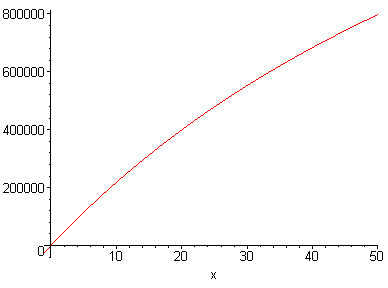Modeling with First Order Differential Equations
Whenever there is a process to be investigated, a mathematical model becomes a possibility. Since most processes involve something changing, derivatives come into play resulting in a differential equation. We will investigate examples of how differential equations can model such processes.
Example A Polluted Pond
A pond initially contains 500,000 gallons of unpolluted water has an outlet that releases 10,000 gallons of water per day. A stream flows into the pond at 12,000 gallons per day containing water with a concentration of 2 grams per gallon of a pollutant. Find a differential equation that models this process and determine what the concentration of pollutant will be after 10 days.
Solution
We let x(t) be amount of pollutant in grams in the pond after t days.
We use a fundament property of rates:
Total Rate = Rate In - Rate Out
To find the rate in we use
grams
gallons
grams
12,000 2
=
=
day
day
gallon
1 1
= 24,000 grams per day
To find the rate out we first notice that since there was initially 500,000 gallons of water in the lake and the water level is increasing at a rate of 2,000 gallons per day, the total number of gallons of water in the lake after t days is
gallons = 500,000 + 2,000 t
The units for the rate out is grams per day. We write
grams
gallons
grams
10,000
x
=
=
day
day
gallon
1 500,000 + 2,000 t
10x
=
grams per day
500 + 2t
Putting this all together, we get
dx
10x
= 24000 -
dt
500 + 2t
This is a first order linear differential equation with
10
p(t)
=
g(t) = 24,000
500 + 2t
We have

Multiplying by the integrating factor and using the reverse product rule gives
((500 + 2t)5x)' = 24,000(500 + 2t)5
Now integrate both sides to get
(500 + 2t)5x = 2,000(500 + 2t)6 + C
C
x
= 2000(500 + 2t) +
(500 + 2t)5
Now use the initial condition to get
C
x
= 2000(500) +
(500)5
C = -3.125 x 1019
Now plug in 10 for t and calculate x
-3.125 x 1019
x
= 2000(500 + 2(10)) +
(500 + 2(10)5
= 218,072 grams
A graph is given below

Example
You just won the lottery. You put your $5,000,000 in winnings into a fund that has a rate of return of 4%. Each year you use $300,000. How much money will you have twenty years from now?
Solution
This is also a
Total Rate = Rate In - Rate Out
problem. Let
x = the balance after t years
The rate out is
300,000
and the rate in is
.04x
We have the differential equation
dx/dt = .04x - 300,000
This is both linear first order and separable. We separate and integrate to obtain
![]()
25ln(.04x - 300,000) = t + C1
.04x - 300,000 = C2 et/25
x = Cet/25 + 7,500,000
Now use the initial condition that when t = 0, x = 5,000,000
5,000,000 = C + 7,500,000
So that
x = -2,500,000 et/25 + 7,500,000
Plugging in 20 for t gives
x = 1,936,148
You will have about 2 million dollars left.
Back to the First Order Differential Equations Home Page
Back to the Differential Equations Home Page
Back to the Math Department Home Page
e-mail Questions and Suggestions